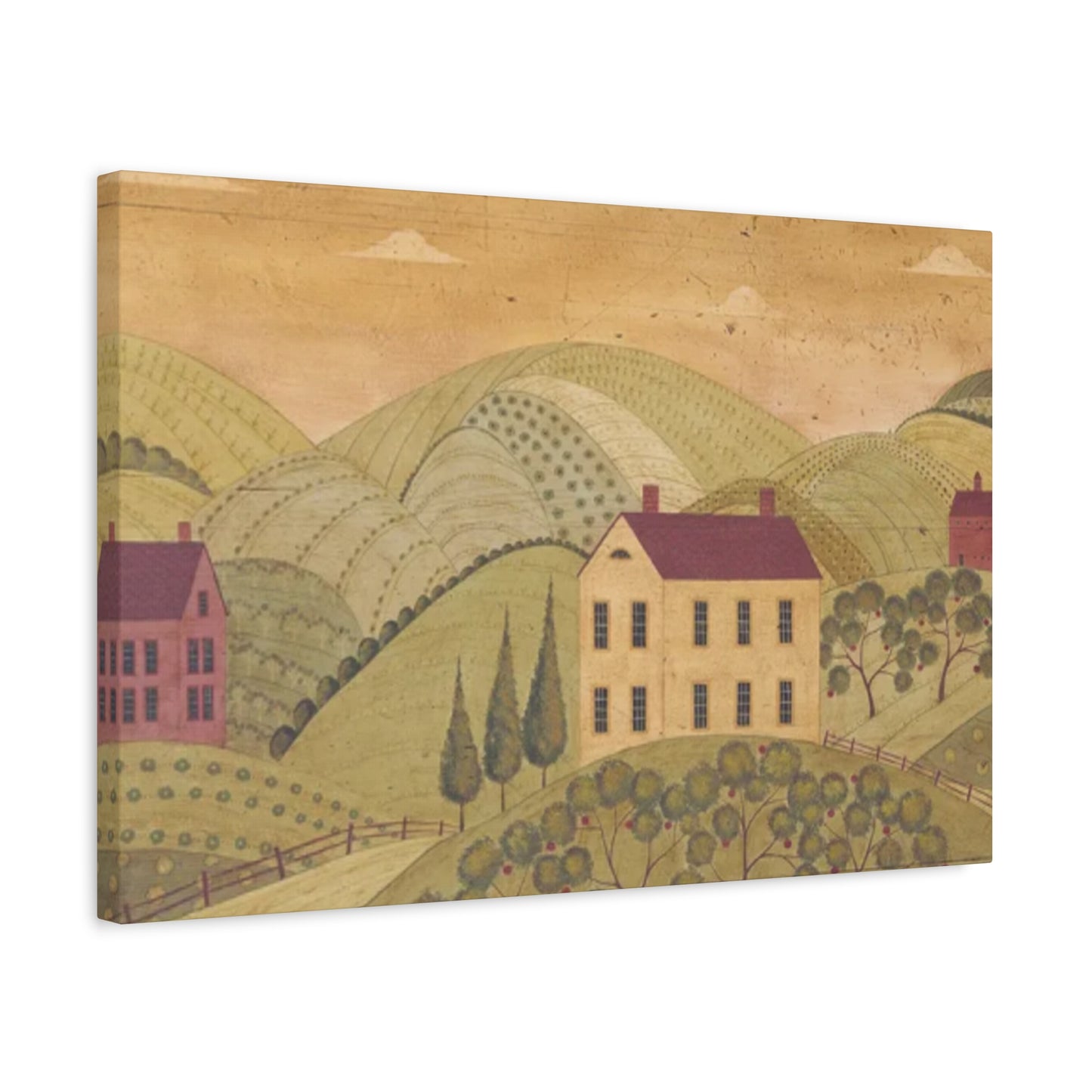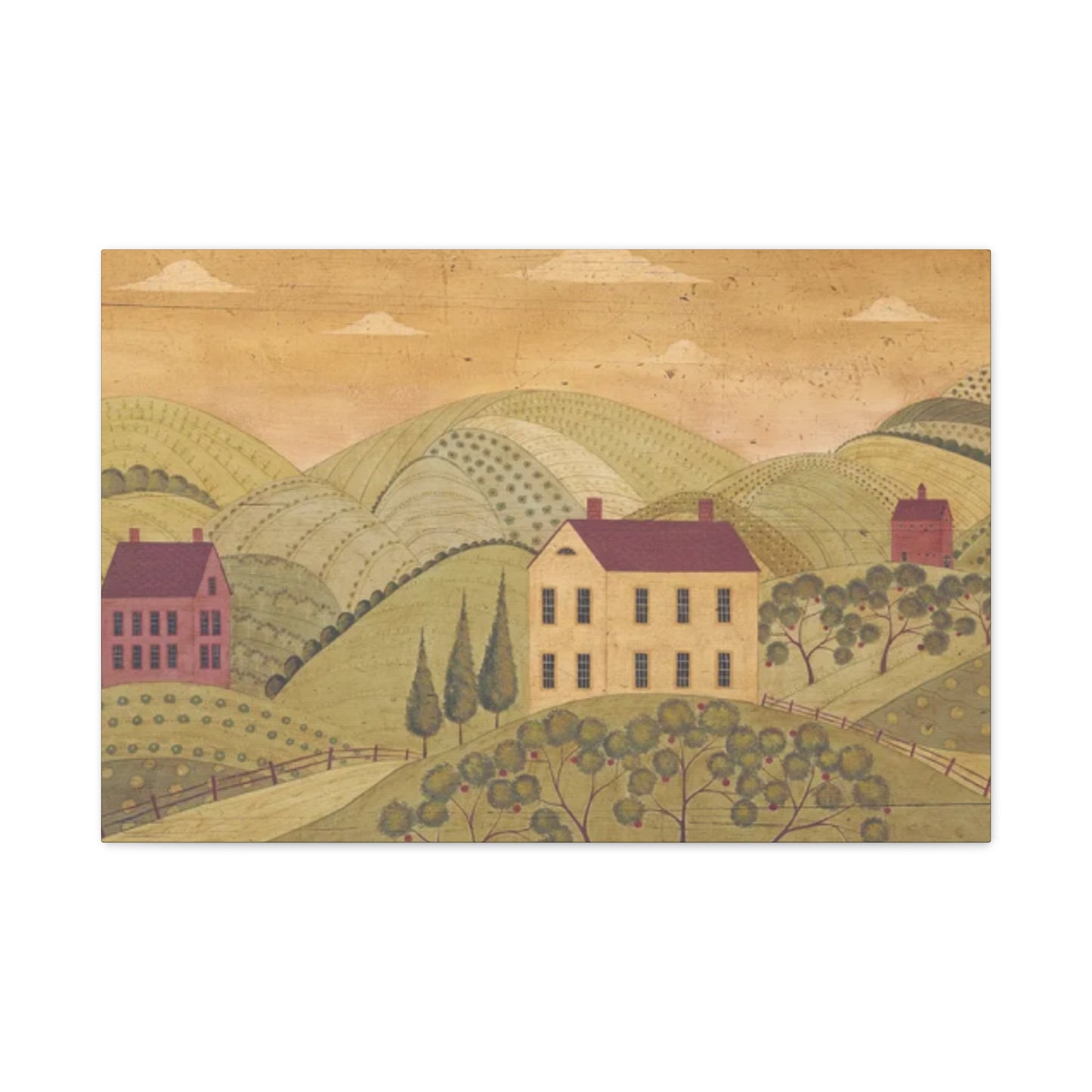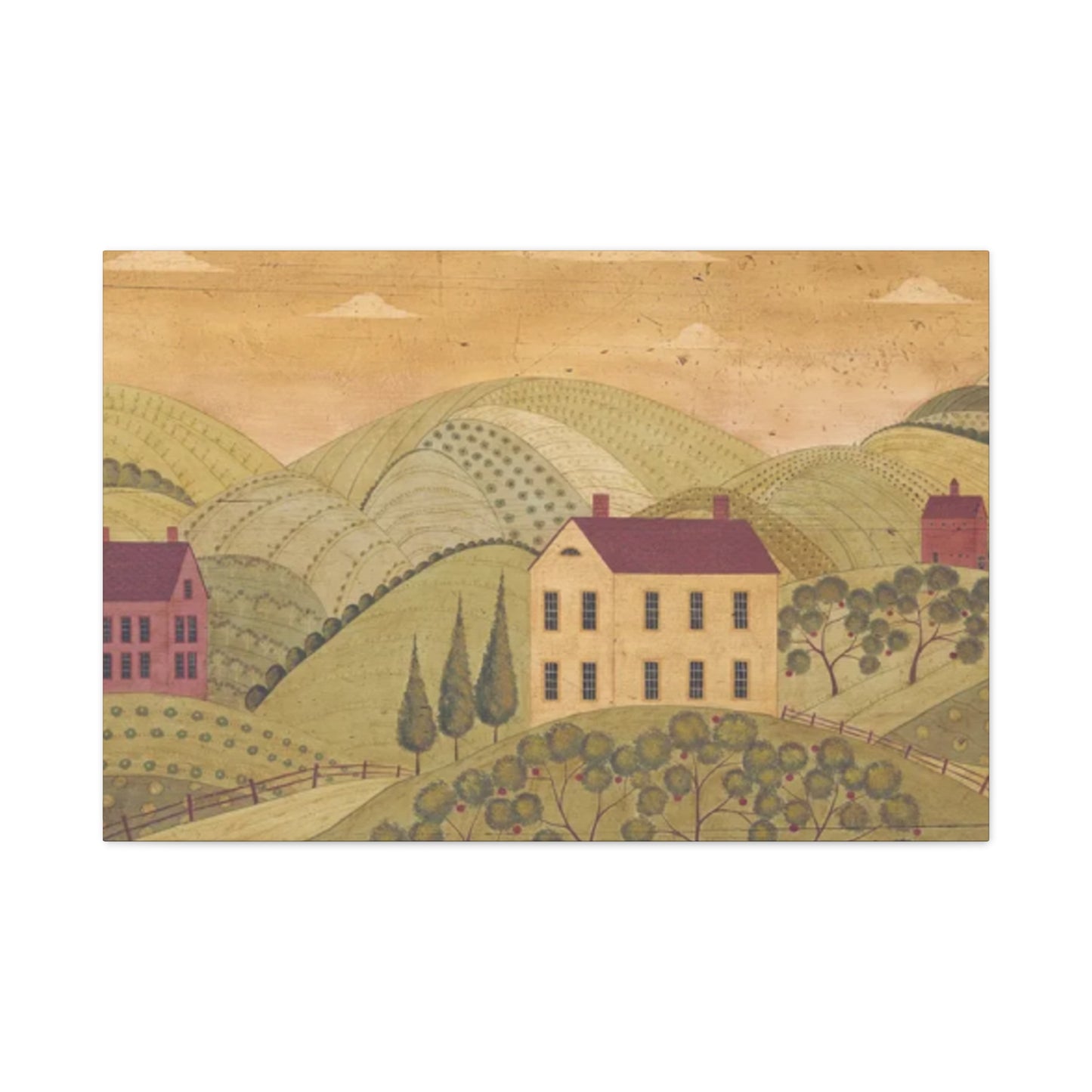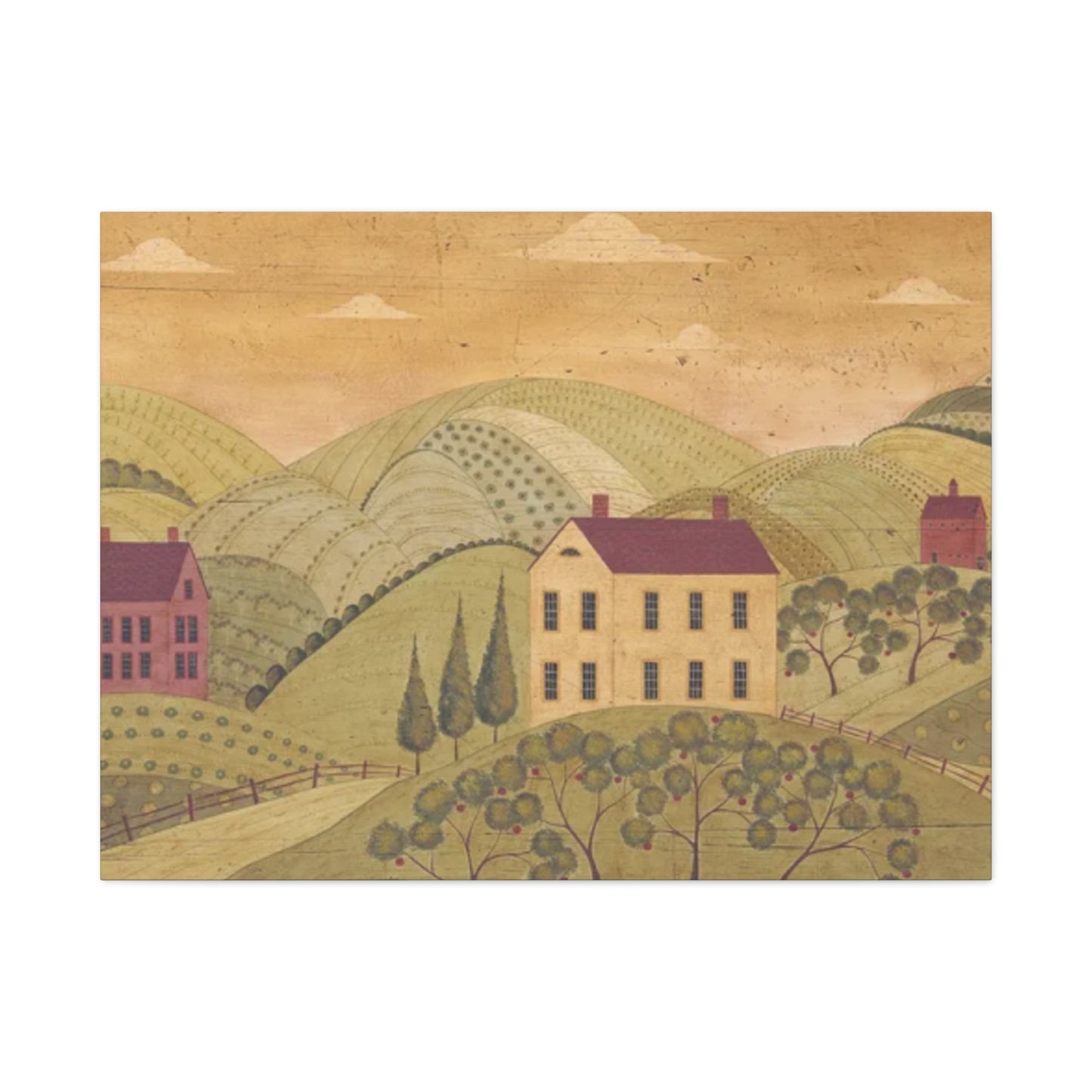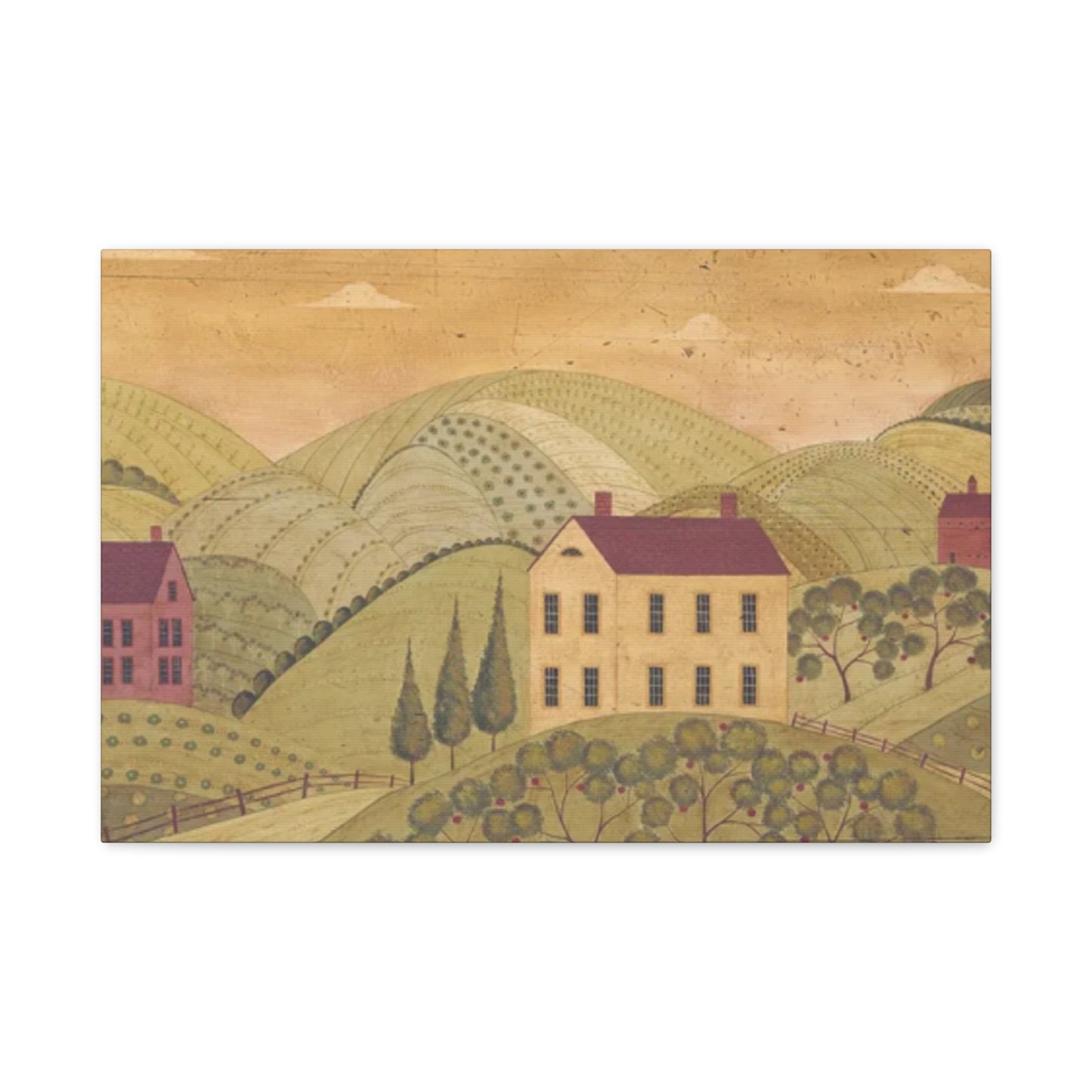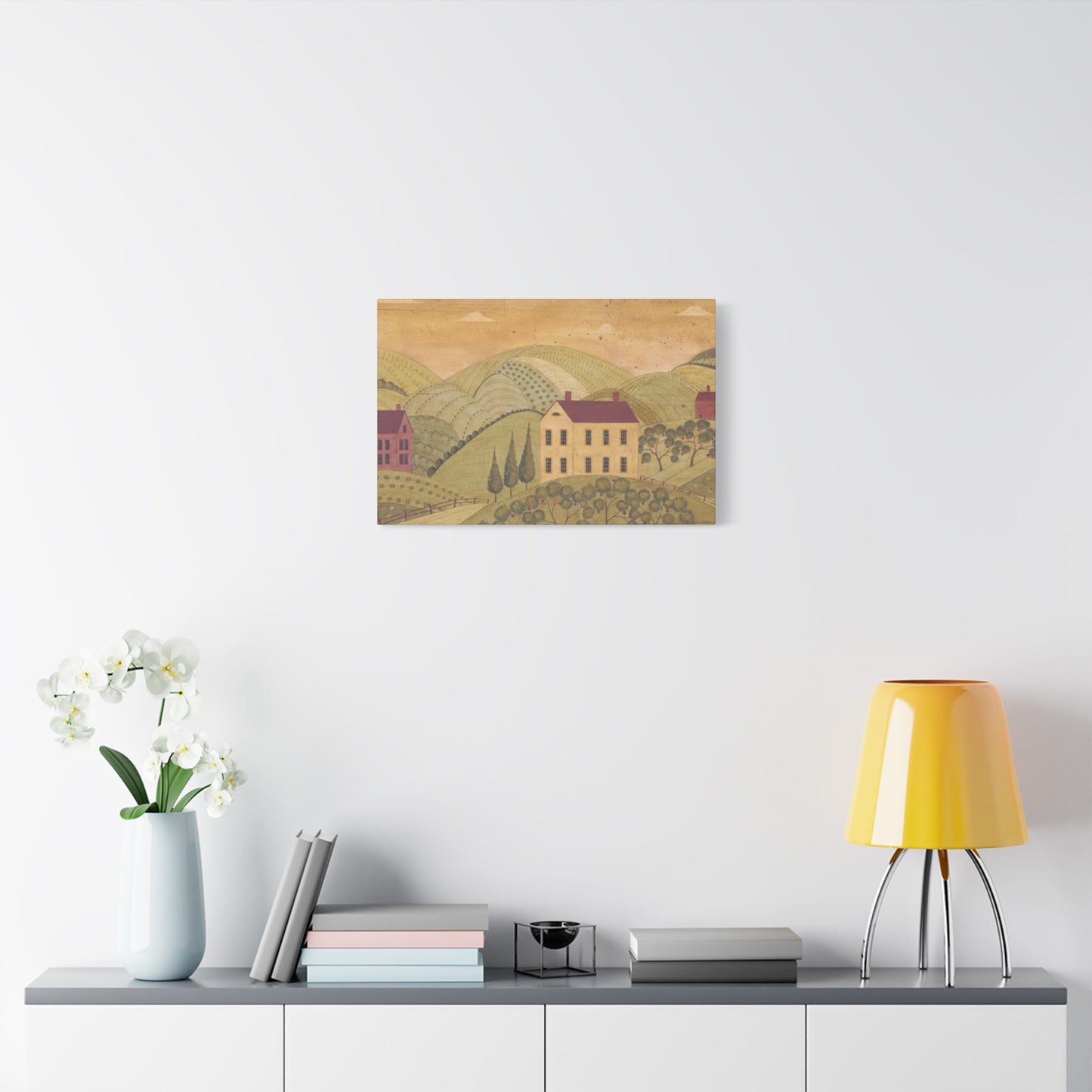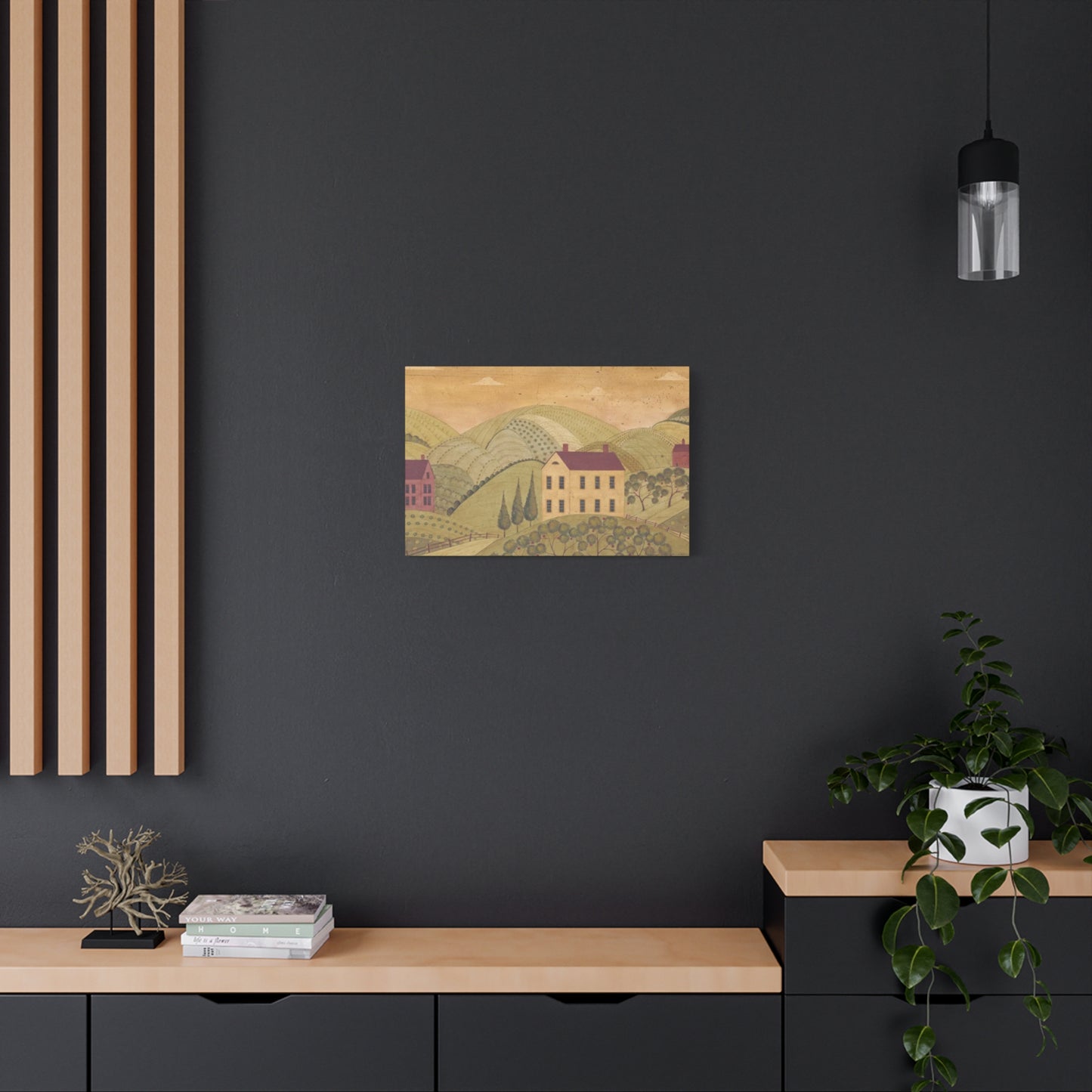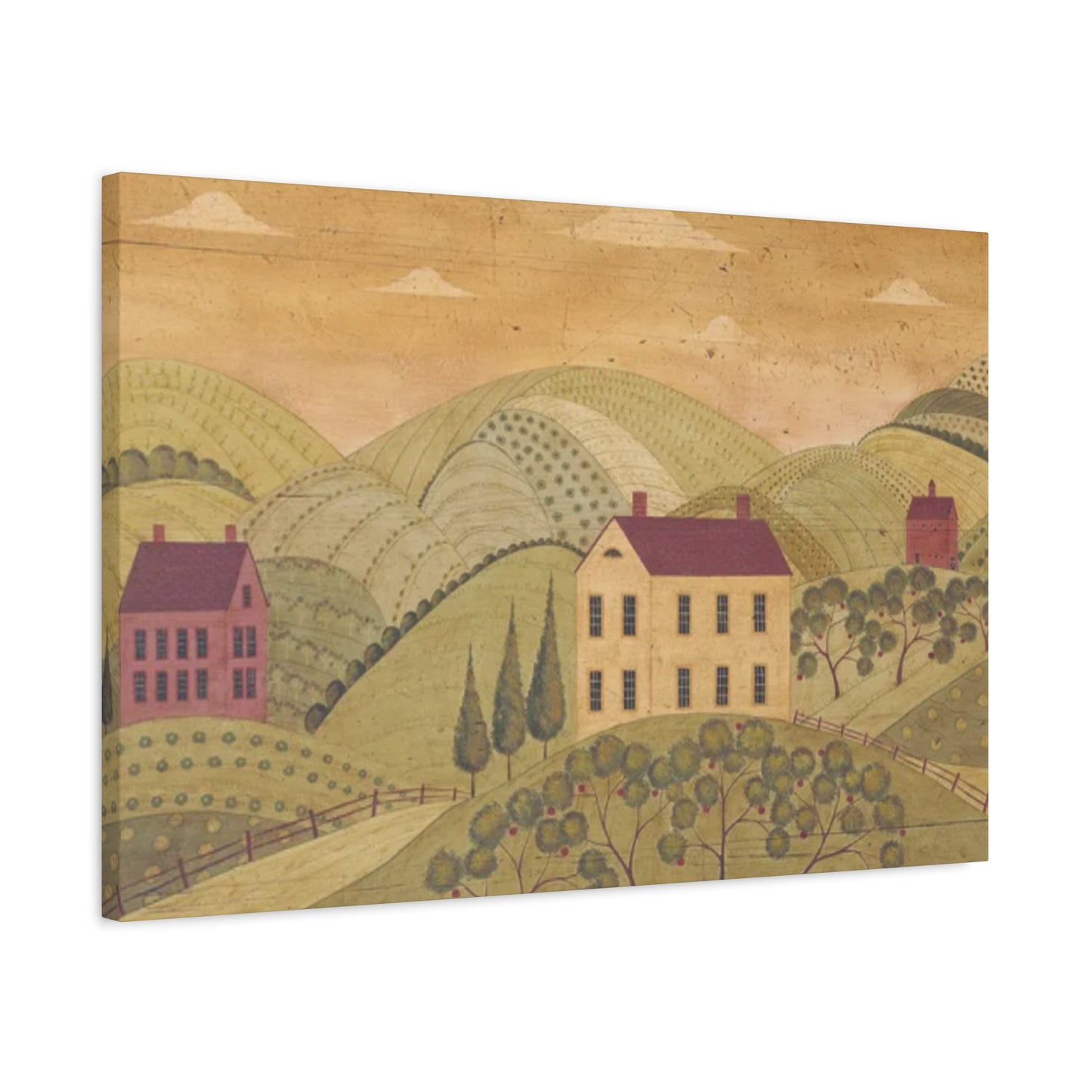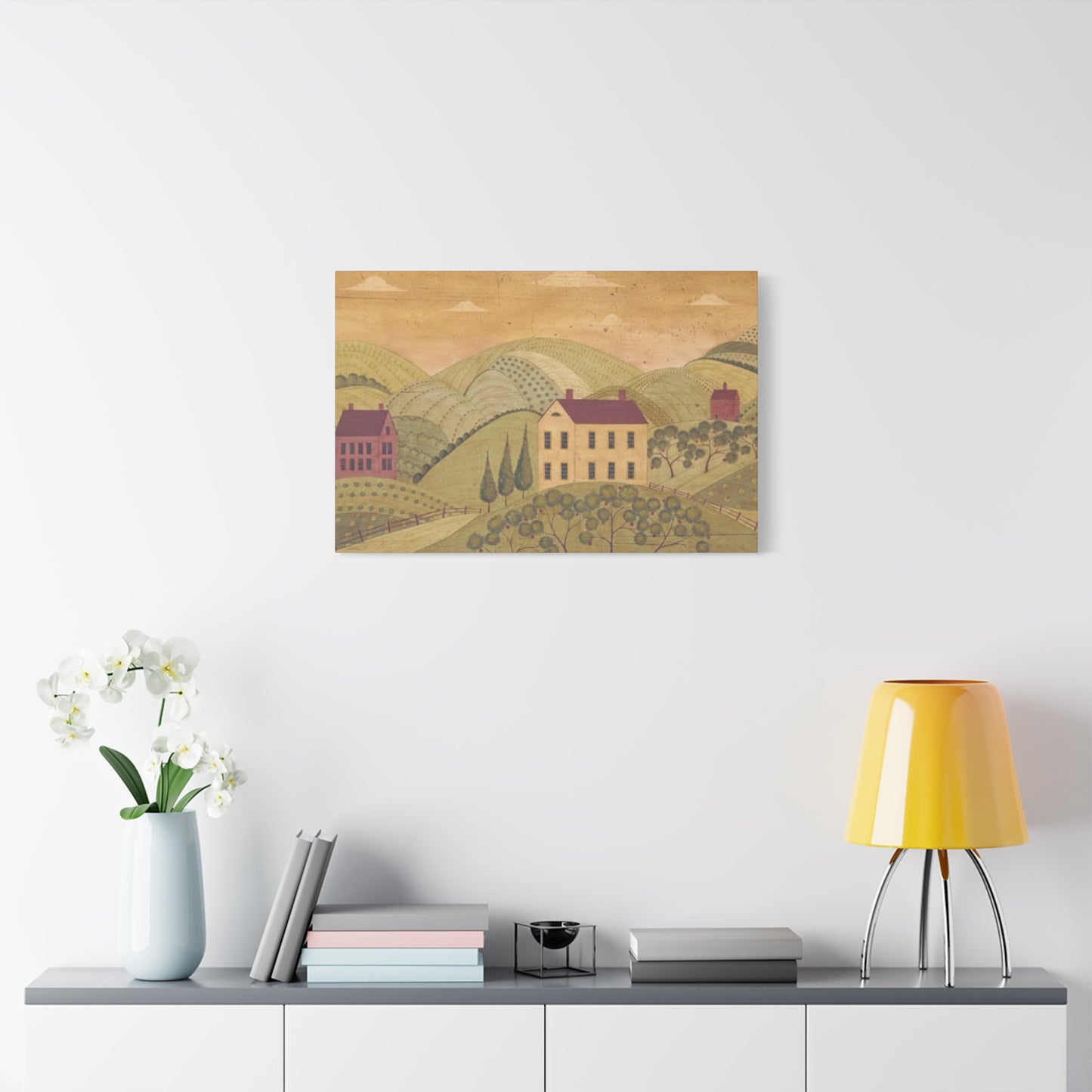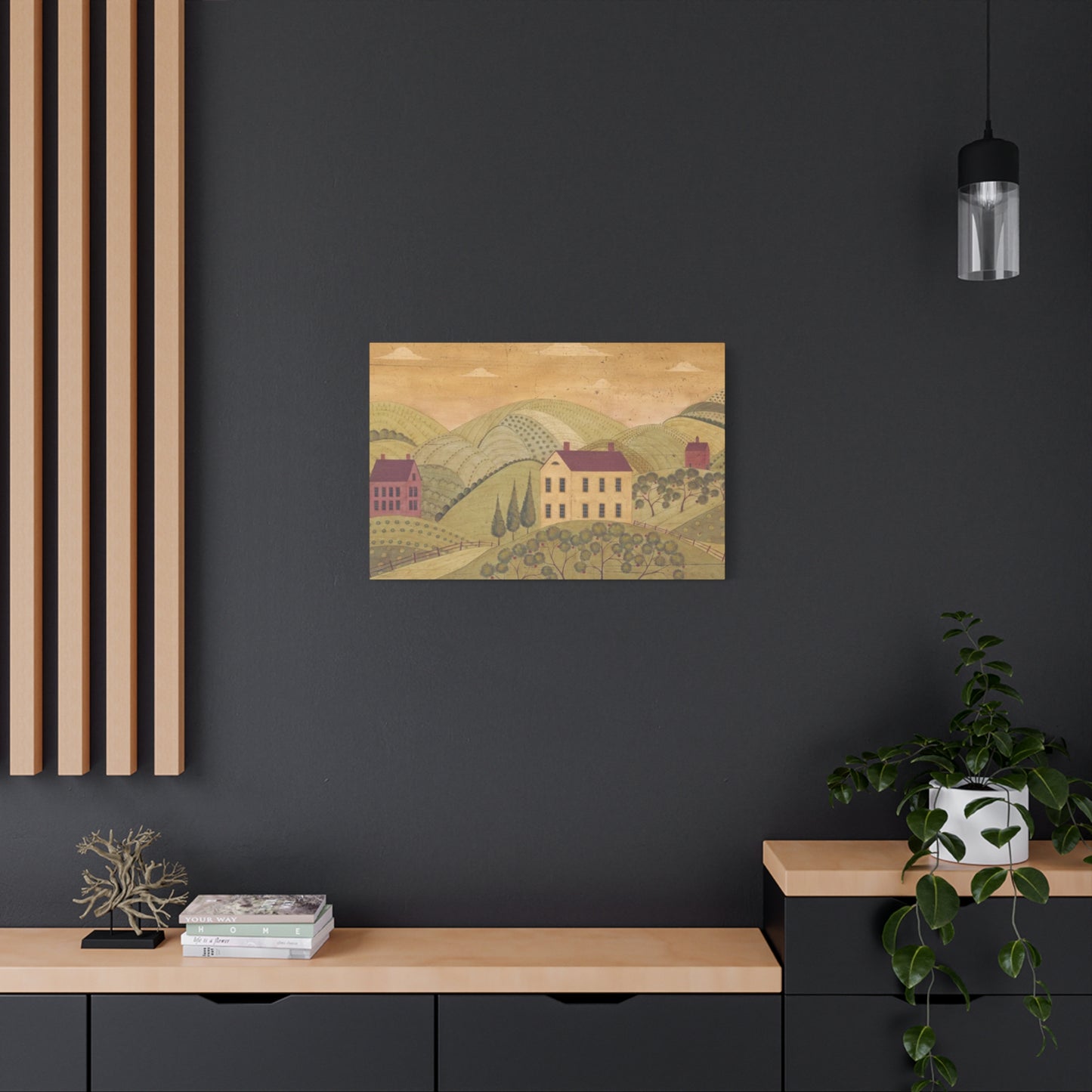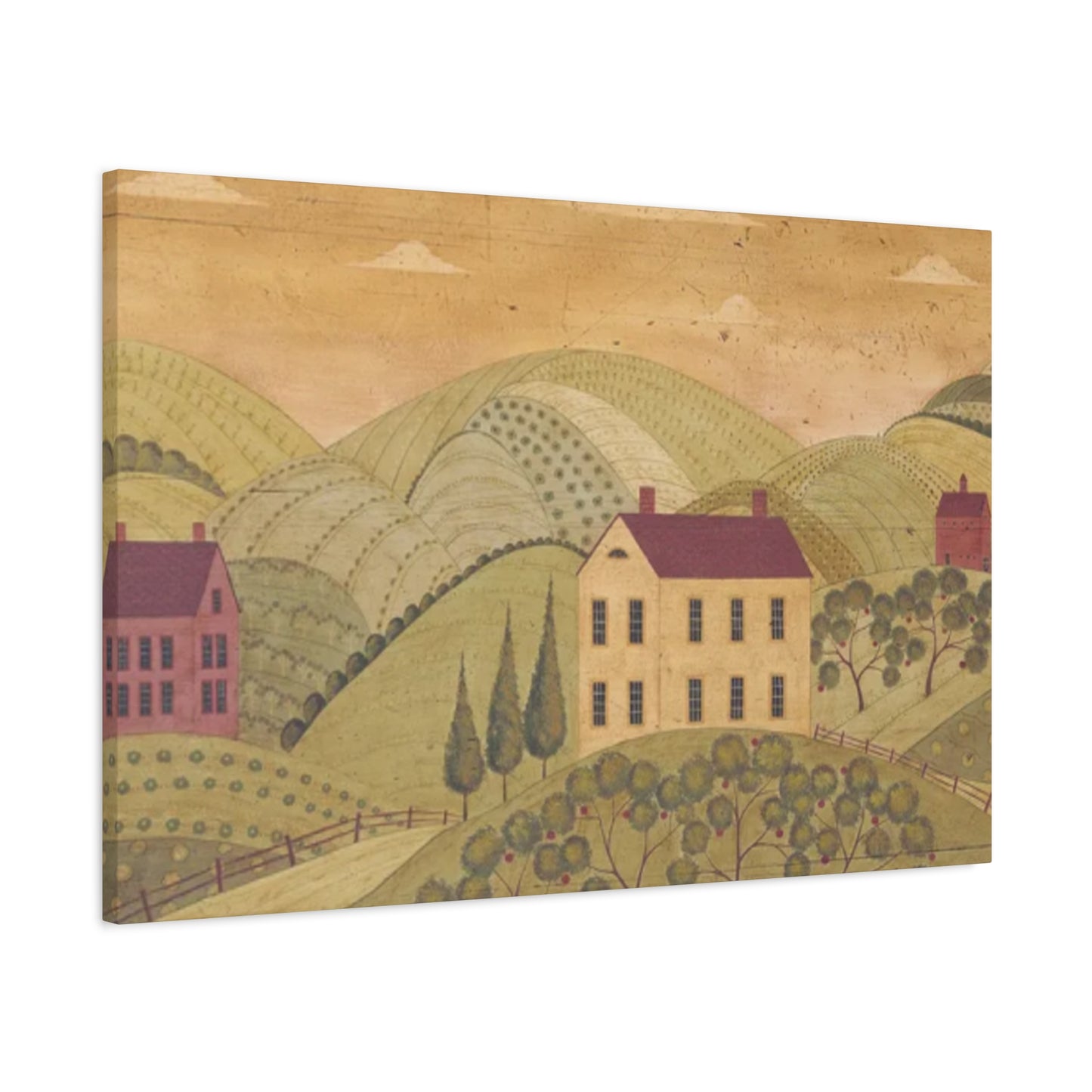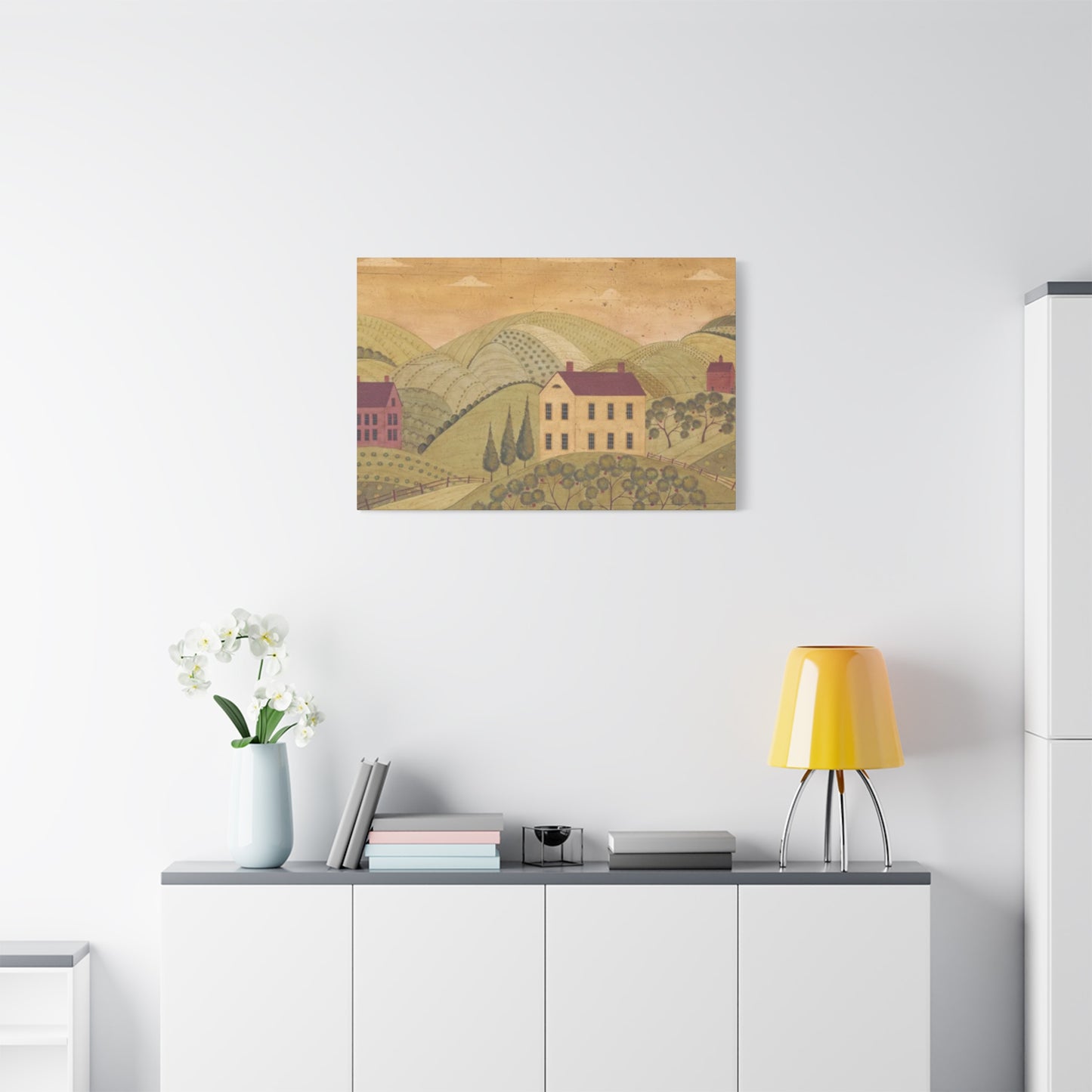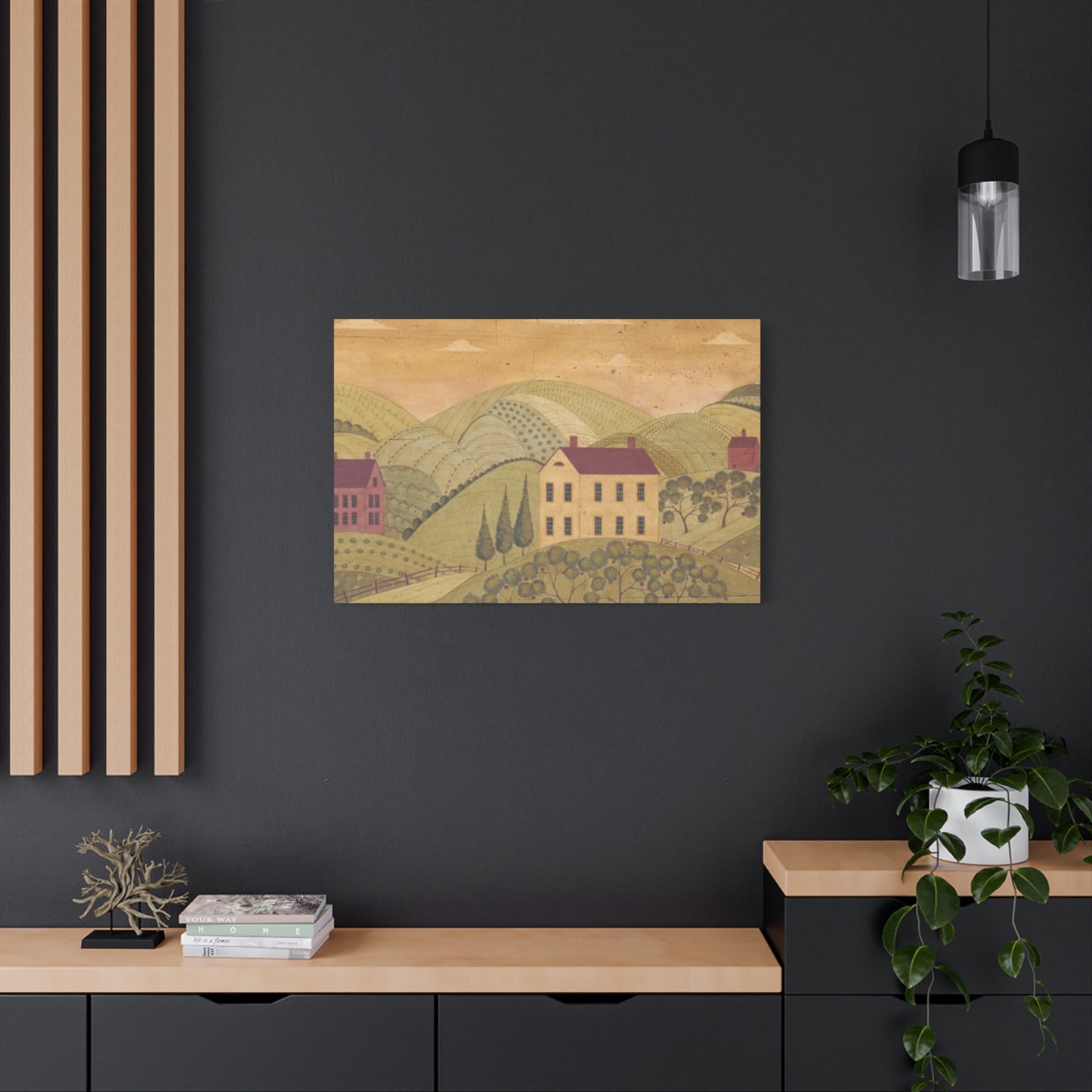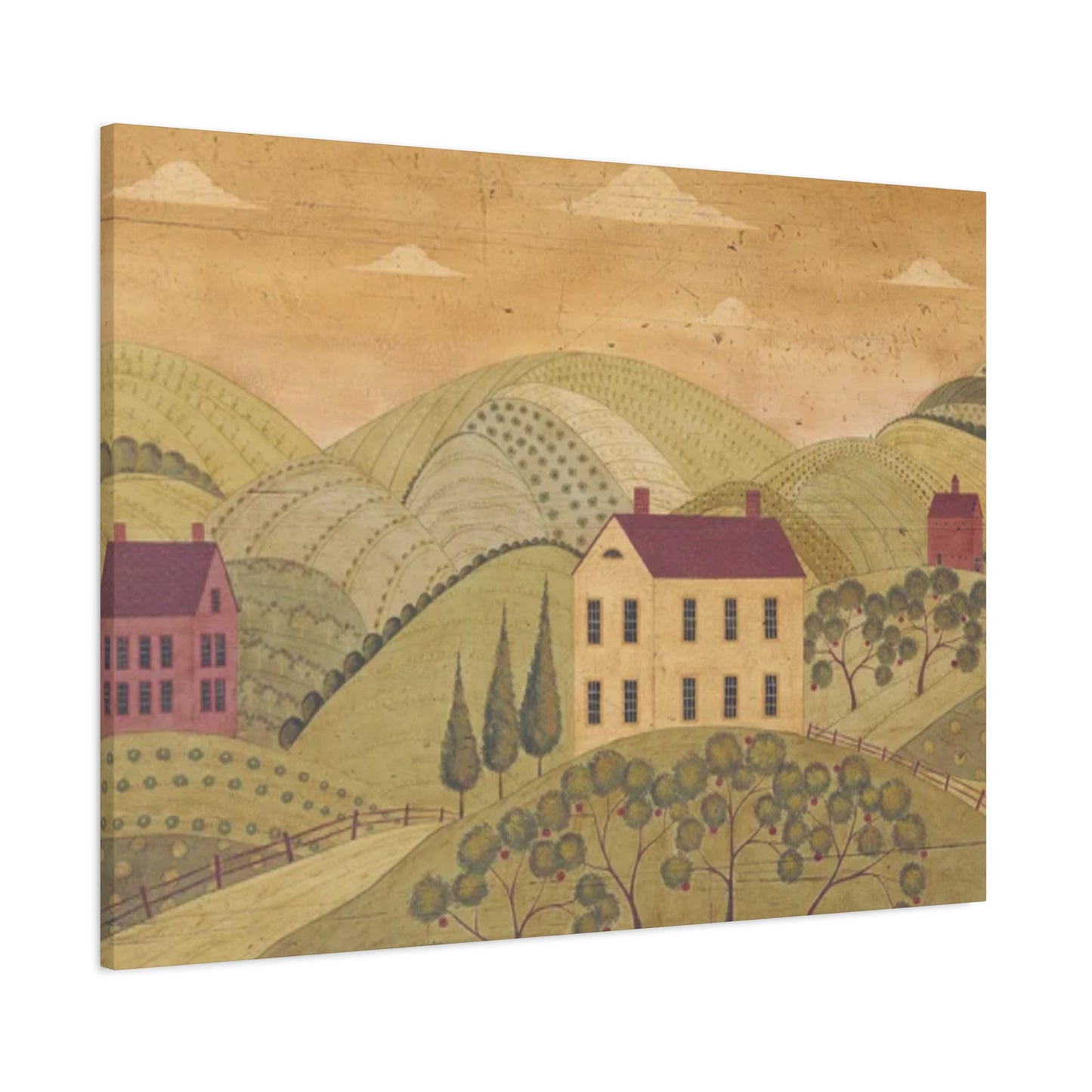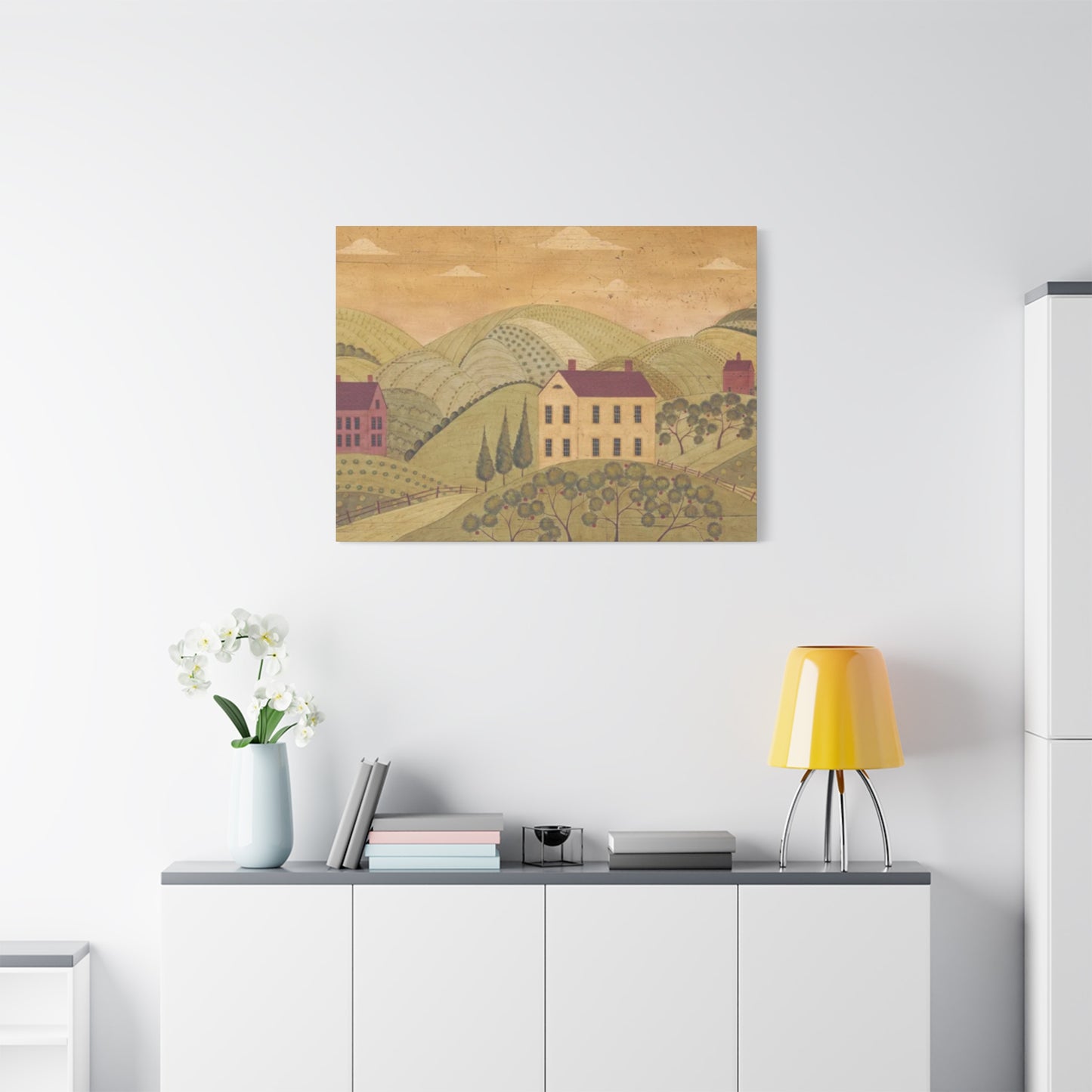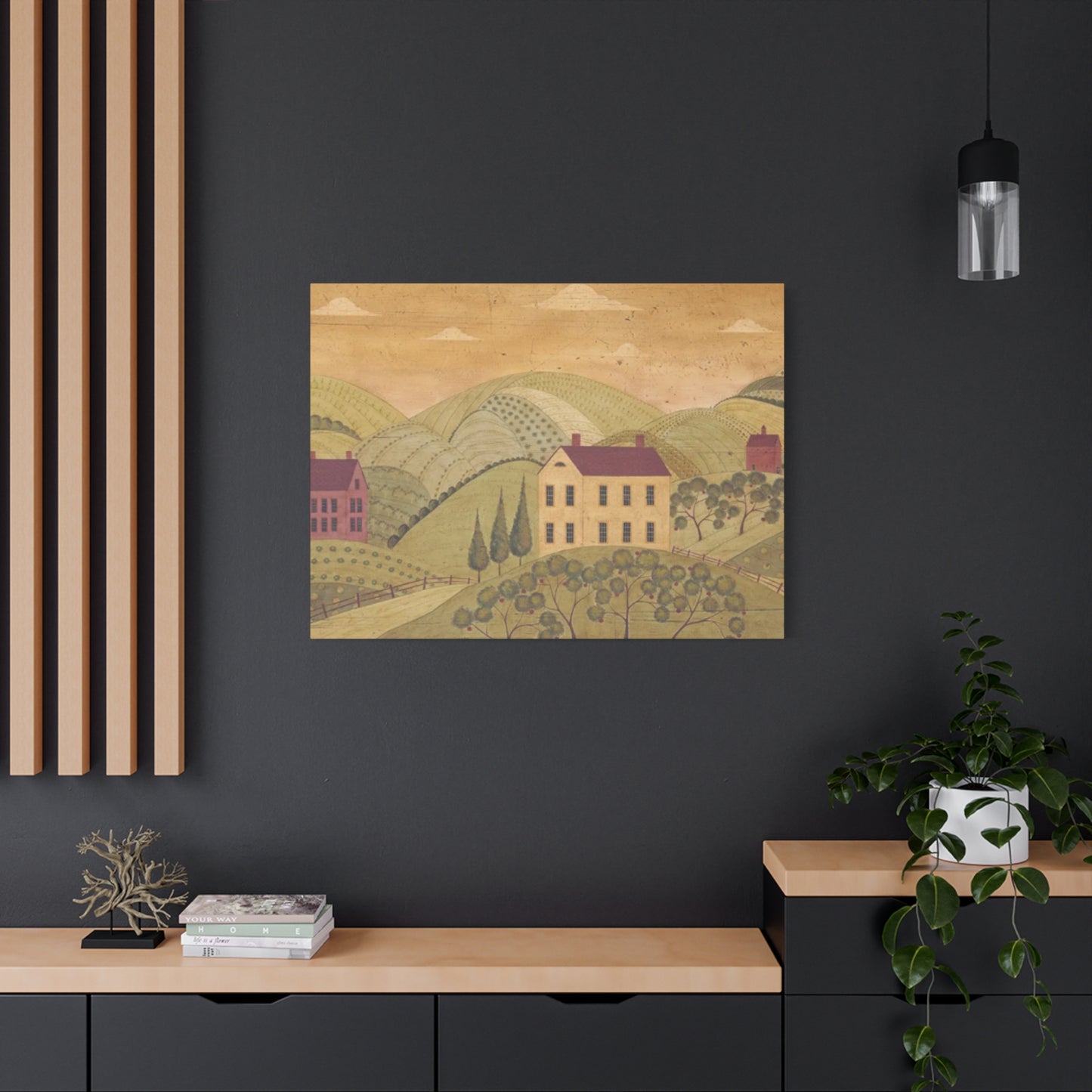Budget Wall Decor: Decorating Your First Apartment with Warren Kimble Wall Art
The enchanting world of rural landscape artwork has captured hearts for generations, bringing the serene beauty of countryside living into homes across the globe. Folk art depicting houses nestled in vast fields represents more than mere decoration; it embodies a connection to simpler times, agricultural heritage, and the enduring appeal of pastoral life. These artistic pieces serve as windows into a world where rolling meadows meet rustic dwellings, creating compositions that resonate with both nostalgia and contemporary aesthetic sensibilities.
Rural landscape artwork encompasses a broad spectrum of artistic expressions, from traditional oil paintings to modern digital prints, each capturing the essence of farmhouse living through unique perspectives. The genre has evolved significantly over centuries, maintaining its core appeal while adapting to changing artistic movements and cultural preferences. Contemporary collectors and homeowners increasingly seek these pieces not only for their visual appeal but also for their ability to create atmospheric environments that promote tranquility and connection to nature.
The significance of field house artwork extends beyond its decorative function, serving as cultural artifacts that preserve rural traditions and ways of life that are increasingly rare in our urbanized world. These artistic interpretations often feature weathered barns, cozy cottages, expansive meadows, and dramatic skies that together create narratives about human relationships with the land. The enduring popularity of such artwork reflects a collective longing for authenticity, simplicity, and the grounding presence of natural environments.
The Magnetic Appeal of Rural Folk Art Depicting Farmhouse Living
Rural folk art possesses an inherent magnetism that transcends cultural boundaries and appeals to diverse aesthetic preferences. The charm of farmhouse scenes lies in their ability to evoke powerful emotional responses through familiar yet idealized representations of countryside living. These artistic works often feature humble dwellings set against expansive agricultural landscapes, creating compositions that celebrate both human ingenuity and natural beauty.
The emotional resonance of farmhouse folk art stems from its representation of fundamental human values such as simplicity, self-sufficiency, and harmony with nature. Viewers often experience a sense of peace and nostalgia when observing these scenes, as they represent an escape from the complexities of modern urban life. The rustic charm of weathered wood structures, rolling hills, and pastoral settings creates an immediate connection to ancestral memories and collective cultural experiences.
Farmhouse folk art typically incorporates elements that celebrate agricultural life, including working farms, seasonal changes, and the cyclical nature of rural existence. Artists often emphasize the relationship between human habitation and the surrounding landscape, showing how farmhouses naturally integrate into their environments rather than dominating them. This organic integration speaks to sustainable living practices and environmental consciousness that resonate with contemporary values.
The artistic techniques employed in farmhouse folk art often emphasize texture, depth, and atmospheric effects that bring these rural scenes to life. Traditional approaches might include impasto techniques that create dimensional surfaces resembling weathered barn wood or textured fields. Color palettes typically draw from earth tones, muted greens, and warm browns that reflect the natural materials and seasonal variations found in agricultural settings.
Contemporary interpretations of farmhouse folk art continue to evolve while maintaining connection to traditional themes. Modern artists might incorporate abstract elements, unusual perspectives, or stylized approaches while preserving the essential character that makes these scenes so appealing. This evolution ensures that farmhouse folk art remains relevant to current aesthetic trends while honoring its historical foundations.
The psychological impact of farmhouse folk art cannot be understated, as these images often provide viewers with mental respite from urban stressors. Research in environmental psychology suggests that exposure to natural imagery, including artistic representations, can reduce stress levels and improve overall well-being. Farmhouse scenes particularly excel at creating these beneficial effects because they combine natural elements with human-scale architecture that feels approachable and comforting.
Exploring Temperature Dynamics in Agricultural Landscape Color Schemes
Color temperature plays a crucial role in determining the emotional impact and visual effectiveness of agricultural landscape artwork. The distinction between warm and cool color palettes dramatically influences how viewers perceive and respond to field and house paintings. Understanding these temperature dynamics enables collectors and homeowners to select pieces that align with their desired aesthetic outcomes and emotional objectives.
Warm color palettes in agricultural landscapes typically feature golden yellows, rich oranges, deep reds, and earth-toned browns that evoke feelings of comfort, energy, and vitality. These colors often appear in sunset scenes, autumn harvest depictions, and representations of sun-drenched fields during peak growing seasons. Warm-toned farmhouse paintings create inviting atmospheres that encourage relaxation and social interaction, making them ideal for gathering areas such as living rooms, dining rooms, and kitchens.
The psychological effects of warm colors in agricultural artwork extend beyond mere aesthetic pleasure, as these hues stimulate feelings of optimism, security, and connection to life-giving forces such as sunlight and fertile soil. Warm color schemes often emphasize the productive aspects of agricultural life, celebrating abundance, harvest seasons, and the rewards of hard work. These paintings frequently feature golden wheat fields, russet-colored barns, and houses bathed in amber light that suggests prosperity and contentment.
Cool color palettes in field and house paintings utilize blues, greens, purples, and gray tones that create atmospheres of tranquility, contemplation, and sophisticated elegance. These cooler schemes often appear in early morning scenes, winter landscapes, or depictions of shadowy pastoral environments. Cool-toned agricultural artwork promotes feelings of calm and reflection, making these pieces particularly suitable for bedrooms, studies, and meditation areas where peaceful environments are desired.
The emotional resonance of cool colors in agricultural settings often emphasizes the more contemplative aspects of rural life, including solitude, seasonal transitions, and the cyclical nature of agricultural existence. Cool color schemes might highlight morning mist over fields, snow-covered farmhouses, or the subtle variations in green that characterize different crops and natural vegetation. These paintings often celebrate the quiet beauty found in agricultural landscapes during less dramatic but equally meaningful moments.
Successful agricultural landscape artwork often incorporates both warm and cool elements to create balanced compositions that offer visual interest and emotional depth. Artists might use warm colors for focal points such as farmhouse windows glowing with interior light while employing cooler tones for sky and distant landscape elements. This temperature contrast creates dimensional effects that draw viewers into the scene and maintain their visual interest over extended periods.
The seasonal associations of different color temperatures provide agricultural landscape artists with powerful tools for storytelling and emotional communication. Spring scenes might combine cool blues and greens with warm yellow accents to suggest renewal and growing energy. Summer paintings often emphasize warm golden tones that celebrate peak agricultural activity. Autumn works typically feature rich warm colors that highlight harvest abundance, while winter scenes rely on cool palettes that emphasize dormancy and quiet reflection.
Understanding color temperature principles enables collectors to make informed decisions about how agricultural landscape artwork will function within their existing environmental schemes. Rooms with predominantly warm architectural elements and furnishings might benefit from cool-toned agricultural paintings that provide visual balance and prevent color overwhelm. Conversely, environments with cool architectural features might be enhanced by warm-toned agricultural artwork that adds energy and visual warmth to otherwise austere settings.
Determining Optimal Dimensions for Rural Dwelling Canvas Artwork
Selecting appropriate dimensions for rural dwelling canvas artwork requires careful consideration of multiple factors including room size, viewing distance, architectural features, and intended visual impact. The scale relationship between artwork and its environment significantly influences the effectiveness of agricultural landscape pieces in creating desired atmospheric effects and visual harmony within residential or commercial settings.
Large-scale rural dwelling canvases, typically measuring 36 inches or larger in at least one dimension, create dramatic focal points that can anchor entire room designs around their agricultural themes. These oversized pieces work exceptionally well in spacious environments such as great rooms, formal dining areas, or master bedrooms where they can be viewed from appropriate distances without overwhelming the visual field. Large agricultural landscapes excel at creating immersive experiences that transport viewers into the depicted rural scenes.
The psychological impact of large-scale agricultural artwork extends beyond mere visual dominance, as oversized pieces can fundamentally alter the perceived character and atmosphere of residential environments. A substantial canvas depicting vast fields and distant farmhouses can make rooms feel more expansive while simultaneously creating intimate connections to the depicted landscape. These pieces often serve as conversation starters and emotional anchors that define the overall aesthetic direction of entire living areas.
Medium-sized rural dwelling canvases, ranging from 16 to 36 inches in their largest dimension, offer versatility and adaptability that makes them suitable for diverse residential applications. These proportions work effectively in most standard room configurations while providing sufficient visual presence to serve as meaningful focal points. Medium-scale agricultural artwork can be successfully grouped in collections or combined with other decorative elements without competing for visual attention.
The flexibility of medium-sized agricultural canvases makes them particularly valuable for homeowners who prefer layered decorative approaches or who might need to relocate artwork as their living situations change. These pieces can transition effectively between different rooms and architectural contexts while maintaining their visual impact and thematic relevance. Medium-scale rural dwelling artwork often provides the optimal balance between presence and integration within existing decorative schemes.
Small-scale rural dwelling canvases, typically under 16 inches in their largest dimension, serve specialized functions within comprehensive decorative approaches while offering unique advantages for specific applications. These intimate pieces work exceptionally well in personal areas such as home offices, bedrooms, or reading nooks where close viewing distances allow for appreciation of detailed artistic elements. Small agricultural landscapes can also function effectively as components within larger gallery wall arrangements.
The charm of small-scale agricultural artwork often lies in its ability to provide detailed glimpses into rural life that reward close examination and contemplation. These pieces might focus on specific architectural details, seasonal textures, or intimate moments within agricultural settings that would be lost in larger-scale treatments. Small rural dwelling canvases offer collectors opportunities to acquire multiple pieces that collectively tell more comprehensive stories about agricultural life and seasonal variations.
Proportional relationships between rural dwelling artwork and surrounding architectural features require careful attention to ensure visual harmony and appropriate emphasis. Artwork that is too small relative to furniture or architectural elements may appear insignificant and fail to achieve desired atmospheric effects. Conversely, pieces that are disproportionately large may overwhelm their environments and create visual tension rather than the intended peaceful agricultural ambiance.
Contemporary approaches to displaying rural dwelling canvases often involve creative arrangements that maximize visual impact while respecting proportional relationships. Triptych presentations allow artists to create expansive agricultural narratives across multiple panels while maintaining individual piece sizes that work within specific architectural constraints. Gallery wall approaches can combine multiple small to medium agricultural pieces to achieve large-scale visual impact while preserving flexibility in arrangement and future modifications.
Selecting Appropriate Frame Styles for Countryside Landscape Prints
The selection of appropriate framing for countryside landscape prints significantly influences their visual presentation, perceived value, and integration within residential environments. Frame choices can enhance the rustic charm of agricultural artwork or provide sophisticated contrast that elevates these pieces within contemporary decorative schemes. Understanding the relationship between frame styles and agricultural content enables collectors to make informed decisions that maximize the aesthetic impact of their countryside landscape investments.
Traditional wooden frames naturally complement countryside landscape prints through material authenticity and textural harmony that reinforces agricultural themes. Reclaimed wood frames, weathered barn wood, or distressed finishes create direct connections between the artwork and the rural environments they depict. These frame choices emphasize the handcrafted, authentic qualities associated with agricultural life while providing warm, organic borders that enhance rather than compete with the depicted landscapes.
The natural variations found in wooden frames, including grain patterns, color variations, and surface textures, create visual interest that supports the organic themes common in countryside artwork. Wide wooden frames can provide substantial presence that anchors agricultural prints within room compositions while narrow wooden profiles offer subtle enhancement that allows the artwork to maintain visual prominence. The choice between different wooden frame approaches should consider both the style of the agricultural content and the broader decorative context.
Rustic metal frames, particularly those featuring aged finishes, oil-rubbed bronze, or weathered steel appearances, offer alternative approaches that maintain connection to agricultural themes while providing different textural contrasts. These frame materials can evoke the industrial elements found in agricultural settings, such as farm equipment, metal roofing, or hardware details that are integral parts of rural landscapes. Metal frames often provide crisp definition that can enhance the clarity and impact of detailed countryside prints.
The durability and clean lines associated with metal framing can create sophisticated presentations that allow countryside landscape prints to function effectively within contemporary environments without sacrificing their agricultural character. Black metal frames, in particular, provide neutral borders that emphasize the colors and compositions within agricultural artwork while maintaining understated elegance that works across diverse decorative styles.
Contemporary frame approaches for countryside landscape prints might incorporate mixed materials, floating presentations, or gallery-style mounting that creates sophisticated display methods while respecting the content's agricultural character. Floating frames, where the artwork appears to hover within the frame structure, can create modern presentations that emphasize the artistic qualities of countryside landscapes while maintaining visual connection to their subject matter.
Gallery-style presentations using simple, clean-lined frames focus attention on the agricultural artwork itself rather than the framing elements. These approaches work particularly well with high-quality photographic countryside prints or contemporary artistic interpretations of agricultural themes. The restraint shown in gallery-style framing can create sophisticated environments where countryside landscape prints achieve status as serious artistic works rather than merely decorative elements.
Custom framing solutions for countryside landscape prints allow for personalized approaches that consider specific artwork characteristics, room requirements, and individual aesthetic preferences. Professional framers can recommend archival materials, appropriate matting approaches, and protective glass options that preserve agricultural prints while enhancing their presentation. Custom framing investments often prove worthwhile for valuable countryside landscape prints or pieces with particular sentimental significance.
Matting choices significantly influence the presentation of countryside landscape prints, with cream, natural, and earth-toned options typically providing harmonious borders that enhance agricultural content without creating visual distraction. Double matting approaches can add dimensional interest and premium appearance while providing additional protection for valuable prints. The width and color choices for matting should complement both the agricultural artwork and the selected frame style to create cohesive presentations.
Incorporating Agricultural Artwork into Contemporary Home Environments
The integration of agricultural artwork into contemporary home environments requires thoughtful consideration of stylistic relationships, color harmonies, and thematic coherence that allows rural landscape pieces to enhance rather than conflict with modern architectural and decorative elements. Successfully incorporating countryside artwork into contemporary settings involves understanding how traditional agricultural themes can complement minimalist aesthetics, clean lines, and sophisticated material palettes that characterize modern residential design.
Contemporary living areas often feature neutral color schemes, natural materials, and streamlined furnishings that can provide excellent backdrops for carefully selected agricultural artwork. The earth tones and organic subjects common in countryside landscapes naturally harmonize with contemporary preferences for natural wood, stone, and textile materials. This inherent compatibility allows agricultural artwork to serve as connecting elements that soften the sometimes austere qualities of contemporary architecture while introducing warmth and visual interest.
The key to successful integration lies in selecting agricultural artwork that shares aesthetic qualities with contemporary design principles while maintaining its rural character. Clean compositions, sophisticated color palettes, and refined execution can allow countryside landscapes to function as serious artistic statements within contemporary environments. These pieces should demonstrate technical excellence and artistic vision that meets the quality standards expected in modern residential settings.
Scale relationships become particularly important when incorporating agricultural artwork into contemporary environments, as modern rooms often feature substantial furniture pieces and architectural elements that require appropriately proportioned artwork to maintain visual balance. Large-scale countryside landscapes can serve as dramatic focal points that anchor contemporary room compositions while providing necessary visual weight to balance substantial furniture groupings or architectural features.
Contemporary presentation methods for agricultural artwork might include sleek mounting systems, gallery lighting, or floating display techniques that emphasize the artistic qualities of countryside landscapes while maintaining connection to modern aesthetic sensibilities. These presentation approaches can elevate agricultural artwork from decorative accessories to serious artistic statements that contribute meaningful visual content to contemporary living environments.
The textural contrasts available through agricultural artwork can provide valuable counterpoints to the smooth, refined surfaces common in contemporary architecture and furnishings. The organic textures depicted in countryside landscapes, including weathered wood, natural stone, vegetation, and atmospheric effects, can add dimensional interest and visual complexity that prevents contemporary environments from feeling sterile or overly controlled.
Lighting considerations play crucial roles in successfully integrating agricultural artwork into contemporary settings, as proper illumination can enhance the atmospheric qualities that make countryside landscapes so appealing while ensuring they receive appropriate visual emphasis within room compositions. Contemporary track lighting, recessed fixtures, or picture lights can provide focused illumination that highlights agricultural artwork without creating glare or color distortion.
The psychological benefits of incorporating agricultural artwork into contemporary environments should not be overlooked, as these pieces can provide necessary connections to nature and simpler ways of life that balance the high-tech, fast-paced qualities of modern existence. Countryside landscapes can serve as visual reminders of seasonal cycles, natural processes, and human relationships with the land that promote emotional well-being and stress reduction.
Strategic placement of agricultural artwork within contemporary environments can create interesting visual narratives that bridge different lifestyle concepts and time periods. A sophisticated countryside landscape in a contemporary kitchen might suggest appreciation for both culinary traditions and modern cooking technologies. Agricultural artwork in contemporary bedrooms can promote restful sleep through associations with peaceful rural environments and natural rhythms.
Understanding Cultural Significance of Dwellings in Rural Landscapes
The cultural significance of dwellings depicted in rural landscapes extends far beyond their function as architectural subjects, representing complex networks of meaning related to human relationships with land, community structures, and cultural values that have shaped agricultural societies throughout history. These humble structures serve as powerful symbols that communicate ideas about home, belonging, self-sufficiency, and the fundamental human need for shelter and security within natural environments.
Rural dwellings in landscape artwork often embody idealized concepts of home that transcend their physical reality, representing emotional and psychological refuges from the complexities of modern life. The visual appeal of farmhouses, cottages, and rural cabins lies partially in their ability to suggest simpler ways of living that prioritize essential human needs over material excess. These structures communicate values such as authenticity, craftsmanship, and connection to place that resonate with viewers seeking meaning and stability in increasingly uncertain times.
The architectural styles commonly depicted in rural landscape artwork reflect regional building traditions that developed in response to local climatic conditions, available materials, and cultural preferences brought by various immigrant populations. These structures serve as historical documents that preserve information about past technologies, social structures, and aesthetic preferences that might otherwise be lost to modernization and urban development. The preservation of these architectural memories through artistic representation maintains cultural continuity and identity.
Farmhouses and rural dwellings often symbolize the American dream of land ownership, self-sufficiency, and individual achievement through hard work and determination. These structures represent tangible evidence of human success in domesticating wild landscapes and creating productive agricultural environments that support families and communities. The idealization of rural dwellings in artwork reflects collective aspirations for independence, security, and meaningful work that creates lasting value.
The positioning of dwellings within expansive rural landscapes communicates important relationships between human habitation and natural environments that differ significantly from urban development patterns. Rural homes typically appear as integrated elements within larger ecological systems rather than as dominant features that impose human will upon natural landscapes. This integration suggests sustainable relationships between human activity and environmental preservation that appeal to contemporary environmental consciousness.
The scale relationships between dwellings and surrounding landscapes in agricultural artwork often emphasize human vulnerability and dependence upon natural forces such as weather, seasonal cycles, and soil fertility. These proportional relationships remind viewers of fundamental realities about human existence that are often obscured by urban living and technological advancement. The humility suggested by small structures within vast landscapes can promote perspectives that value cooperation with natural systems rather than domination over them.
Rural dwellings in landscape artwork frequently feature evidence of human activity and ongoing maintenance that suggests continuity of habitation and care over extended periods. Details such as smoke rising from chimneys, well-maintained gardens, farm equipment, and domestic animals communicate stories about daily life and seasonal activities that connect viewers to fundamental human experiences related to shelter, food production, and community cooperation.
The emotional resonance of rural dwellings stems partially from their associations with family life, generational continuity, and the transmission of cultural values across time periods. These structures often suggest multi-generational habitation where knowledge, skills, and traditions pass from parents to children within stable community contexts. The nostalgia evoked by rural dwelling imagery reflects longing for these forms of social continuity that may be less common in contemporary urban environments.
Contemporary interpretations of rural dwellings in landscape artwork might explore changing relationships between human habitation and agricultural land use as traditional farming practices evolve in response to technological advancement and economic pressures. Modern agricultural artwork might address themes such as sustainable development, environmental stewardship, and the preservation of rural communities in the face of urbanization and industrialization pressures.
Artistic Techniques for Depicting Natural Elements in Agricultural Settings
The artistic representation of natural elements within agricultural settings requires sophisticated understanding of how various textures, atmospheric conditions, and organic forms contribute to the overall emotional impact and visual authenticity of rural landscape artwork. Master artists develop specialized techniques for depicting grass textures, sky variations, tree characteristics, and architectural details that combine to create convincing and emotionally resonant agricultural scenes.
Grass and meadow textures present particular challenges for artists working in agricultural themes, as these elements must suggest both individual blade characteristics and broader field patterns that create convincing landscape depth and seasonal variation. Successful grass rendering often involves layering techniques that build complex surface textures through multiple applications of paint or other media. Artists might begin with broad color washes that establish overall field tones before adding increasingly detailed texture work that suggests individual plants and growth patterns.
The direction and character of brushstrokes used in grass depiction can communicate important information about wind movement, seasonal conditions, and the specific types of vegetation present in agricultural settings. Short, vertical strokes might suggest new spring growth, while longer, flowing strokes could indicate mature grasses moving in wind. The color variations within grass textures should reflect seasonal changes, soil conditions, and the diverse plant species typically found in agricultural environments.
Sky treatments in agricultural landscape artwork often serve as dramatic focal points that establish mood, suggest weather conditions, and provide compositional balance for foreground elements including dwellings and field textures. The vastness of sky areas in rural landscapes provides artists with opportunities to create spectacular atmospheric effects that can dominate entire compositions. Cloud formations, light quality, and color gradations all contribute to the emotional impact of agricultural scenes.
Techniques for rendering convincing skies might include wet-on-wet blending approaches that create soft cloud edges and smooth color transitions, or more controlled layering methods that build complex atmospheric effects through careful color relationships. The interaction between sky colors and landscape elements below requires careful attention to reflected light effects and atmospheric perspective that creates convincing dimensional relationships within agricultural compositions.
Tree depiction in agricultural settings must account for the specific species commonly found in farming regions, their seasonal variations, and their functional roles within agricultural landscapes. Trees in rural settings often serve practical purposes such as windbreaks, shade provision, or boundary markers, and their artistic representation should reflect these functional relationships while contributing to overall compositional effectiveness.
The structural characteristics of different tree species require different artistic approaches, with deciduous trees demanding attention to seasonal foliage variations while evergreen species maintain more consistent appearance throughout yearly cycles. The interaction of trees with atmospheric conditions such as morning mist, bright sunlight, or storm conditions provides opportunities for dramatic lighting effects that enhance the emotional impact of agricultural landscape artwork.
Architectural detail rendering in agricultural artwork requires understanding of traditional rural building techniques, materials, and weathering patterns that create authentic representations of farmhouses, barns, and outbuildings. The texture of weathered wood siding, the pattern of roof materials, and the character of foundation work all contribute to the credibility and emotional resonance of rural dwelling depictions.
Artists developing agricultural artwork must understand how different architectural materials weather and age under rural conditions, as these aging processes contribute significantly to the charm and authenticity that make farmhouse imagery so appealing. The patina of aged metal roofing, the silvering of weathered wood, and the settling patterns of stone foundations all provide opportunities for textural richness that enhances artistic impact.
Water elements in agricultural settings, including ponds, streams, irrigation channels, and seasonal flooding areas, require specialized techniques that capture both the reflective properties of water surfaces and their integration within broader landscape compositions. Water features often serve as compositional focal points that provide visual relief from the texture-heavy elements common in agricultural artwork while contributing essential narrative elements about agricultural water management and seasonal cycles.
Discovering Sources for Authentic Rural Landscape Artwork
The search for authentic rural landscape artwork requires understanding diverse market channels, artist networks, and quality indicators that distinguish genuine agricultural-themed pieces from mass-produced decorative items. Serious collectors and homeowners seeking meaningful countryside artwork must navigate various purchasing environments while developing expertise in evaluating artistic merit, authenticity, and investment potential within this specialized market segment.
Local art fairs and agricultural exhibitions often provide excellent opportunities to discover regional artists who specialize in rural landscape themes and possess intimate knowledge of local agricultural practices, architectural styles, and environmental conditions. These venues allow direct interaction with artists, providing insights into their creative processes, inspiration sources, and technical approaches that create more meaningful connections between collectors and artwork. Regional art events often feature artists whose work authentically represents specific geographic areas and cultural traditions.
Art galleries specializing in American regionalism, folk art, or contemporary landscape painting frequently maintain collections of high-quality rural landscape artwork from established and emerging artists. Gallery relationships provide access to curated selections, professional authentication services, and ongoing support for collectors building comprehensive agricultural art collections. Gallery representation often indicates artists have achieved recognition within professional art communities and maintain consistent quality standards.
Estate sales and antique markets can yield valuable discoveries of vintage rural landscape artwork, including pieces by historically significant artists or works that document specific time periods and regional characteristics. These purchasing opportunities require developed expertise in authentication, condition assessment, and market valuation to avoid costly mistakes while potentially uncovering exceptional pieces at attractive prices. Estate sale purchases often come with fascinating provenance stories that add historical and emotional value to agricultural artwork.
Online marketplaces and digital galleries have expanded access to rural landscape artwork from artists worldwide while providing convenient comparison shopping and detailed artwork documentation. However, online purchasing requires additional caution regarding authenticity verification, color accuracy, and condition assessment that can be challenging without physical examination. Reputable online art dealers often provide detailed photographs, condition reports, and return policies that help minimize purchasing risks.
Commission opportunities with artists specializing in rural landscape themes allow collectors to obtain personalized artwork that incorporates specific architectural elements, landscape features, or seasonal conditions that hold personal significance. Custom agricultural artwork can commemorate family properties, document historical buildings, or capture specific geographic locations that might not be available through existing artworks. Commission processes provide unique opportunities to participate in artwork creation while supporting living artists.
Art schools and university galleries often showcase work by emerging artists exploring rural landscape themes through contemporary perspectives and innovative techniques. These venues provide opportunities to discover new talents while potentially acquiring artwork at attractive prices before artists achieve broader market recognition. Student and faculty exhibitions can reveal cutting-edge approaches to traditional agricultural subjects that bridge historical themes with contemporary artistic concerns.
Museum gift shops and cultural institutions focused on agricultural heritage, rural history, or regional art often offer carefully curated selections of rural landscape artwork that meet professional quality standards. These sources typically provide educational context about featured artists, historical periods, or regional significance that enhances understanding and appreciation of purchased pieces. Museum-affiliated purchases often come with authentication and scholarly documentation that supports long-term value retention.
Auction houses occasionally feature rural landscape artwork within broader American art sales, providing opportunities to acquire pieces by recognized artists or historically significant works that might otherwise be unavailable. Auction participation requires understanding bidding procedures, condition assessment, and market valuation while accepting risks associated with competitive purchasing environments. Successful auction purchases often require considerable research and preparation to identify valuable opportunities and establish appropriate bidding limits.
Harmonizing Agricultural Artwork with Plant-Based Decorative Elements
The combination of agricultural artwork with botanical decorative elements creates layered environmental schemes that celebrate multiple aspects of natural beauty while establishing coherent thematic relationships throughout residential settings. This harmonious integration requires careful attention to scale relationships, color coordination, and stylistic compatibility that allows both artwork and living plants to enhance each other's visual impact without creating competing focal points or overwhelming busy compositions.
Living plants provide dimensional contrast and seasonal variation that complement the static nature of agricultural artwork while introducing organic textures, natural colors, and subtle movement that enhance overall environmental appeal. The selection of appropriate plant species should consider their visual characteristics, maintenance requirements, and symbolic relationships with agricultural themes depicted in countryside artwork. Plants that suggest farming activities or rural environments can strengthen thematic coherence while providing practical benefits such as air purification and humidity regulation.
Herb gardens and edible plants create particularly meaningful connections with agricultural artwork themes while providing functional benefits that extend beyond purely decorative considerations. Kitchen herbs such as rosemary, thyme, and sage echo the practical plant knowledge associated with rural living while contributing aromatic elements that engage additional sensory experiences. These edible plants can be displayed in containers that complement the rustic character of agricultural artwork through material choices such as galvanized metal, weathered wood, or natural clay pottery.
Seasonal flower arrangements that reflect the growing cycles depicted in agricultural artwork can provide dynamic elements that change throughout the year while maintaining thematic consistency with countryside landscape themes. Spring arrangements might feature bulb flowers and fresh greenery that echo renewal themes common in agricultural art, while autumn displays could incorporate harvest materials such as dried grasses, seed pods, and seasonal fruits that reinforce agricultural abundance themes.
The container choices for botanical elements should harmonize with agricultural artwork through material selections, color relationships, and stylistic approaches that create unified environmental schemes. Rustic containers made from natural materials such as wood, stone, or metal can strengthen connections to agricultural themes while providing appropriate settings for both living plants and cut flower arrangements. The weathered, aged qualities valued in agricultural artwork can be echoed through container choices that suggest authentic farm origins.
Dried botanical materials, including preserved flowers, grasses, and harvest materials, offer permanent decorative elements that maintain consistent appearance while providing textural interest that complements agricultural artwork. These preserved materials can be arranged in ways that suggest seasonal agricultural activities such as harvest celebrations or farmhouse flower preservation traditions. Dried arrangements require minimal maintenance while providing lasting decorative impact that doesn't compete with artwork for attention.
The scale relationships between botanical elements and agricultural artwork require careful consideration to ensure visual balance and appropriate emphasis within room compositions. Large plants should be proportioned to complement rather than overwhelm agricultural artwork, while smaller botanical elements can be arranged in groupings that provide visual weight appropriate to their environmental context. The positioning of plants relative to artwork should consider lighting requirements for both elements while creating pleasing compositional relationships.
Color coordination between living plants and agricultural artwork can be achieved through plant selection that emphasizes foliage colors, flower tones, or container choices that harmonize with color palettes used in countryside landscape pieces. Plants with silver-green foliage might complement cool-toned agricultural artwork, while plants featuring warm green colors could enhance warm-toned countryside paintings. Flowering plants should be selected for bloom colors that harmonize with rather than compete against agricultural artwork.
Lighting considerations become more complex when combining living plants with agricultural artwork, as both elements have specific illumination requirements that must be balanced within unified lighting schemes. Natural light sources should be maximized to benefit plant health while providing appropriate illumination for artwork appreciation. Artificial lighting systems might need to accommodate both plant growing requirements and artwork display needs through carefully planned fixture positioning and bulb selection.
Creative Display Concepts for Rural Landscape Artwork
The development of creative display concepts for rural landscape artwork involves exploring innovative presentation approaches that maximize visual impact while respecting the authentic character and thematic content that makes countryside imagery so appealing. Contemporary display strategies can elevate agricultural artwork from simple wall decoration to sophisticated design elements that anchor entire room compositions and create immersive environmental experiences.
Gallery wall arrangements featuring multiple rural landscape pieces allow for complex storytelling that can document seasonal changes, regional variations, or historical periods within agricultural themes. These multi-piece displays require careful attention to size relationships, color harmonies, and compositional flow that guides viewer attention while maintaining individual artwork integrity. Gallery walls can combine different artistic media, time periods, or stylistic approaches unified by agricultural subject matter.
The planning process for agricultural artwork gallery walls should consider both individual piece characteristics and overall compositional relationships that create dynamic but balanced visual arrangements. Larger pieces often serve as anchor points around which smaller works can be arranged, while color relationships between pieces can be used to create visual flow and thematic continuity. The spacing between individual artworks should allow each piece to maintain its visual identity while contributing to larger compositional effects.
Layered display approaches can create dimensional interest and sophisticated presentation methods that emphasize different aspects of agricultural artwork while providing flexibility for seasonal changes or collection expansion. These arrangements might combine framed pieces with three-dimensional objects such as vintage farm tools, pottery, or botanical elements that reinforce agricultural themes through material authenticity and functional associations.
The depth variations possible in layered displays can be achieved through shelf systems, picture ledges, or custom mounting approaches that allow agricultural artwork to be arranged at different distances from wall surfaces. These dimensional differences create shadow patterns and visual complexity that enhance overall environmental interest while providing practical flexibility for rearranging pieces as collections grow or seasonal preferences change.
Dramatic lighting installations can transform agricultural artwork into focal points that dominate entire room compositions through strategic illumination that emphasizes atmospheric qualities inherent in countryside landscape imagery. Track lighting systems, picture lights, or accent fixtures can be positioned to create theatrical effects that enhance the emotional impact of rural scenes while providing practical illumination for artwork appreciation and room function.
The quality and color temperature of lighting used with agricultural artwork significantly influences mood and visual effectiveness, with warm light sources typically enhancing the cozy, inviting qualities associated with countryside imagery. Dimming capabilities allow for adjustment of lighting intensity to match different times of day or specific activities while maintaining consistent artwork presentation. Natural light integration should be planned to complement rather than compete with artificial lighting systems.
Seasonal display rotations provide opportunities to showcase different aspects of agricultural artwork collections while maintaining environmental freshness and continuing viewer interest. These programmed changes might emphasize different seasonal themes, color relationships, or artistic styles that reflect changing preferences or commemoration of specific agricultural cycles. Seasonal rotations can also protect valuable artwork from extended light exposure while allowing comprehensive collection enjoyment over time.
Storage and rotation systems for agricultural artwork should provide proper environmental protection while maintaining organization that facilitates easy access for display changes. Climate-controlled storage areas, protective wrapping materials, and documentation systems help preserve artwork condition while enabling flexible display programming. Digital documentation of different display arrangements can aid in future planning and provide reference materials for successful presentations.
Illumination Strategies for Agricultural Landscape Artwork
The strategic illumination of agricultural landscape artwork requires sophisticated understanding of how different lighting approaches can enhance or diminish the atmospheric qualities that make countryside imagery so emotionally compelling. Proper lighting design considers both technical requirements for artwork preservation and aesthetic goals for creating immersive environmental experiences that maximize the visual and emotional impact of rural landscape pieces.
Natural lighting represents the ideal illumination source for agricultural artwork, as daylight provides full spectrum color rendition that accurately displays the subtle color relationships and atmospheric effects that characterize high-quality countryside landscape pieces. The positioning of agricultural artwork relative to windows, skylights, and other natural light sources should maximize beneficial illumination while protecting against harmful direct sunlight that can cause fading and deterioration over extended exposure periods.
The quality of natural light changes throughout daily and seasonal cycles, creating dynamic illumination conditions that can dramatically alter the appearance and emotional impact of agricultural artwork. Morning light tends to provide cool, clear illumination that emphasizes detail and color accuracy, while afternoon light often features warmer color temperatures that enhance the cozy, inviting qualities associated with farmhouse imagery. Understanding these variations helps in selecting optimal placement locations for agricultural artwork.
Artificial lighting systems for agricultural artwork must balance preservation requirements with presentation objectives while providing consistent illumination quality that allows for reliable artwork appreciation regardless of natural light conditions. LED lighting technology has revolutionized artwork illumination through energy efficiency, minimal heat production, and precise color control that can be optimized for agricultural landscape imagery characteristics.
Track lighting systems offer flexibility and precise control that makes them particularly suitable for agricultural artwork display in residential environments. Multiple fixtures can be positioned to provide even illumination across large pieces while accent fixtures can highlight specific areas of interest within complex rural landscape compositions. Track systems accommodate future collection changes and rearrangement without requiring extensive electrical modifications.
Picture lighting fixtures mounted directly on or adjacent to agricultural artwork provide intimate illumination that can create dramatic presentation effects while minimizing environmental light pollution. These dedicated fixtures allow for independent control of individual artwork pieces while providing focused illumination that enhances detail visibility and color saturation. Picture lights work particularly well with traditionally styled agricultural artwork that benefits from classical presentation approaches.
The color temperature of artificial lighting significantly influences the appearance and emotional impact of agricultural artwork, with warm light sources typically enhancing the inviting, comfortable associations of countryside imagery. Color temperatures between 2700K and 3000K provide warm illumination that supports the cozy qualities valued in farmhouse artwork while avoiding the harsh, institutional qualities associated with cooler light sources.
Conclusion
Decorating your first apartment on a budget can be both exciting and challenging, and Warren Kimble wall art offers a perfect blend of affordability, charm, and artistic value to help you create a warm, inviting space. Known for his nostalgic Americana style and heartfelt storytelling through art, Kimble’s pieces bring a sense of comfort, family, and simplicity that resonates deeply with many first-time renters looking to make a house feel like home.
One of the great advantages of Warren Kimble wall art is its accessibility. His work often features scenes of everyday life filled with warmth and authenticity, making it easy to find pieces that fit a variety of decorating styles—from rustic to modern farmhouse—without breaking the bank. For someone starting out in a new space, this art not only adds personality but also sparks conversation and evokes feelings of belonging and nostalgia.
Budget-conscious decorators will appreciate that Kimble’s artwork comes in a range of formats, including prints and posters, which can fit well within modest price points while still offering high-quality visual appeal. This flexibility allows you to mix and match pieces, experiment with different arrangements, and gradually build a collection that grows with your taste and space. Additionally, the rich storytelling in each piece brings depth and character to your walls, transforming plain rooms into spaces that feel lived-in and loved.
Moreover, investing in Warren Kimble wall art supports artists who create meaningful, narrative-driven works that enrich our everyday environments. Unlike generic mass-produced art, Kimble’s paintings connect on a personal level, making your apartment feel unique and thoughtfully curated.
In conclusion, when it comes to budget wall decor, Warren Kimble’s art offers an ideal solution for decorating your first apartment. His heartfelt, accessible artwork provides an affordable way to add warmth, style, and character to your living space. By incorporating Kimble’s charming depictions of life and family, you create a home that tells your story—one filled with hope, comfort, and a touch of Americana nostalgia. Decorating on a budget doesn’t mean compromising on quality or meaning; with the right pieces, your first apartment can become a beautiful, inspiring sanctuary from day one.

















